تقوم DeFelsko بتصنيع العديد من أدوات سماكة الطلاء والطلاء التي تقيس سمك مسحوق الطلاء على مجموعة متنوعة من الركائز بما في ذلك الفولاذ والألمنيوم والخشب - قبل أو بعد المعالجة. توضح هذه المقالة حلول قياس سمك مسحوق الطلاء وتسرد وثائق اختبار معايير ASTM المناسبة.
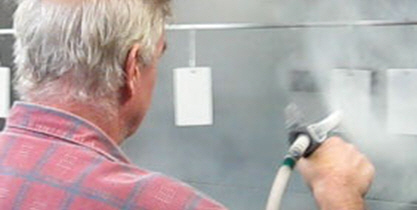
يمكن أخذ قياسات سمك مسحوق الطلاء قبل وبعد المعالجة. يحدد نوع الركيزة ونطاق سمك مسحوق الطلاء وشكل الجزء والاقتصاد أفضل طريقة يمكن استخدامها.
بالنسبة للمساحيق المطبقة غير المعالجة ، يمكن إجراء قياس الارتفاع باستخدام أمشاط المسحوق ومقاييس سمك الطلاء المغناطيسي باستخدام مجسات مسحوق خاصة. هذه التقنيات مدمرة وقد تتطلب إعادة طلاء الجزء. تتناقص مساحيق الطلاء بشكل عام في السماكة أثناء عملية المعالجة ، لذا تتطلب هذه الإجراءات تحديد عامل اختزال للتنبؤ بسمك الفيلم المعالج.
تقيس أدوات الموجات فوق الصوتية أيضا مسحوقا غير معالج ، ولكنها تفعل ذلك دون لمس السطح. بدلا من قياس ارتفاع المسحوق ، فإنها تعرض تلقائيا نتيجة سمك الشفاء المتوقعة.
لقياس ما بعد العلاج ، تتوفر مجموعة متنوعة من الأدوات المحمولة. تستخدم هذه الأدوات غير المدمرة إما مبادئ مغناطيسية أو تيار دوامي أو فوق صوتي اعتمادا على الركيزة. تشمل الطرق الأقل شيوعا قياس الميكرومتر ، وطرق الأغشية الجافة المدمرة مثل المقطع العرضي ، وقياس الجاذبية (الكتلة).

نبدأ بمناقشة قياس ما بعد المعالجة لمجرد أن أهداف السماكة المعالجة هي القيم التي غالبًا ما يتم توفيرها من قبل كل من مصنعي المساحيق ومحددي الطلاء. أجهزة قياس سُمك الغشاء الجاف (DFT) شائعة وبأسعار معقولة وغير مدمرة وسهلة التشغيل. وهي تستخدم مبادئ المغناطيسية أو التيار الدوامي أو الموجات فوق الصوتية اعتمادًا على الركيزة.
يتم استخدام ثلاثة مبادئ للتشغيل. يستخدم مبدأ مغناطيسي لقياس الطلاءات غير المغناطيسية على الأجزاء الفولاذية. بالنسبة للمعادن الأخرى ، مثل الألومنيوم ، يتم استخدام مبدأ التيار الدوامي بشرط أن يكون الطلاء غير موصل للكهرباء. بالنسبة لغير المعادن ، يتم استخدام مبدأ الموجات فوق الصوتية.
عندما يكون الجزء مصنوعا من الفولاذ ، يتم إجراء القياسات باستخدام مقياس سمك مغناطيسي باستخدام التشغيل الميكانيكي أو الإلكتروني.
تستخدم عدادات السحب الميكانيكية مغناطيسا دائما. يتم تحديد سمك المعالجة عن طريق قياس القوة المطلوبة لسحب هذا المغناطيس من سطح الفولاذ المطلي. عدادات السحب المغناطيسية متينة وبسيطة وغير مكلفة ومحمولة ، وعادة لا تتطلب أي تعديل معايرة. إنها بديل جيد ومنخفض التكلفة في المواقف التي تتطلب فيها أهداف الجودة قراءات قليلة فقط أثناء الإنتاج.
تقوم شركة ديفيلسكو بتصنيع أداتين ميكانيكيتين. الأداة PosiTest FM هي عبارة عن نموذج قرص دوار يتكون من مغناطيس متصل بأحد طرفي ذراع متوازن محوري ومتصل بنابض شعر معاير. من خلال تدوير القرص بإصبع، يزيد النابض من القوة على المغناطيس ويسحبه من السطح. وهو آمن في البيئات القابلة للانفجار ويستخدم عادةً من قِبل مقاولي الطلاء وعمليات الطلاء بالمساحيق الصغيرة. تبلغ نسبة التفاوت المسموح به ± 5%.
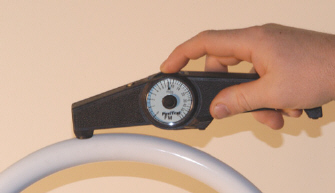
نماذج من نوع قلم الرصاص ، مثلPosiPen، استخدم مغناطيسا مثبتا على زنبرك حلزوني يعمل بشكل عمودي على السطح المطلي. مثالية للأجزاء الصغيرة أو لفحوصات الجودة السريعة ،PosiPenيحتوي على طرف مسبار أصغر يسمح بوضعه بدقة متناهية على الأجزاء الصغيرة والمناطق التي يصعب الوصول إليها والأسطح المنحنية. نطاق درجة الحرارة من -100 إلى 230 درجة مئوية (-150 إلى 450 درجة فهرنهايت) يجعلها مثالية لأخذ القياسات على الأجزاء الساخنة الطازجة من الفرن. لديها تسامح بنسبة ±10٪.
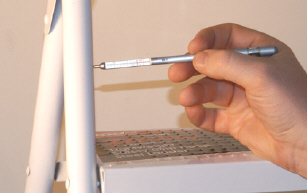
تتوفر مجموعة متنوعة من الأدوات الإلكترونية لقياس سمك طلاء مسحوق العلاج على الأجزاء المعدنية. يستخدمون مبدأ مغناطيسي عند القياس على الفولاذ ومبدأ التيار الدوامي على الألومنيوم. يتم عرض نتائج القياس على شاشة كريستال سائل (LCD) سهلة القراءة. يتراوح التسامح النموذجي بين ±1٪ و ±3٪.
يُطلق على حلنا الإلكتروني الأساسي اسم PosiTest DFT. يتوفر موديلان، كل منهما قادر على قياس ما يصل إلى 1000 ميكرون (40 مل). يوصى باستخدام الطراز PosiTest DFT الحديدي للركائز الفولاذية، بينما يُعد طراز PosiTest DFT Combo مثاليًا للقياس على جميع الركائز المعدنية.

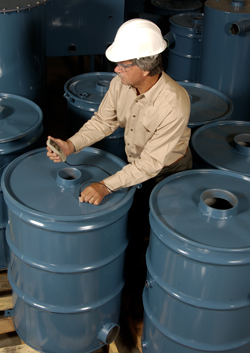
أكثر أدواتنا شيوعًا لمقاييس الطلاء بالمساحيق هي سلسلة مقاييس PosiTector 6000. وهي مثالية للقياس غير المدمر لسُمك الطلاء بالمسحوق على الركائز المعدنية. تتوفر نماذج مختلفة من PosiTector 6000 بما في ذلك سلسلة F للركائز الفولاذية، وسلسلة N للركائز غير الفولاذية مثل الألومنيوم، وسلسلة FN لقياس أي من التطبيقات. وتتوفرأجهزة ميكروبروبس ذات دقة أعلى حديدية أو غير حديديةميكروبس عالية الدقة، بمدى يصل إلى 625 ميكرون (25 مل) للقياس في المناطق الأصغر التي يصعب الوصول إليها. يمكن للنماذج Advanced تخزين القراءات وطباعتها وتنزيلها. ومع ازدياد عدد العملاء الذين يشترون مقاييس سماكة الطلاء للتحقق من جودة المنتجات الواردة، أصبح من المهم بشكل متزايد أن يكون لدى شركات الطلاء بالمساحيق القدرة على تسجيل بيانات مراقبة الجودة بشكل دائم. حتى أن بعض شركات الطلاء بالمساحيق اتخذت الخطوة التالية المتمثلة في تزويد عملائها بتقارير غير مرغوب فيها توضح قراءات سُمك الطلاء كدليل على جودة العملية.
يصف ASTM D7091 القياسات غير المدمرة على الركائز المعدنية المصنوعة من مقاييس سمك الطلاء المغناطيسي والدوامة.
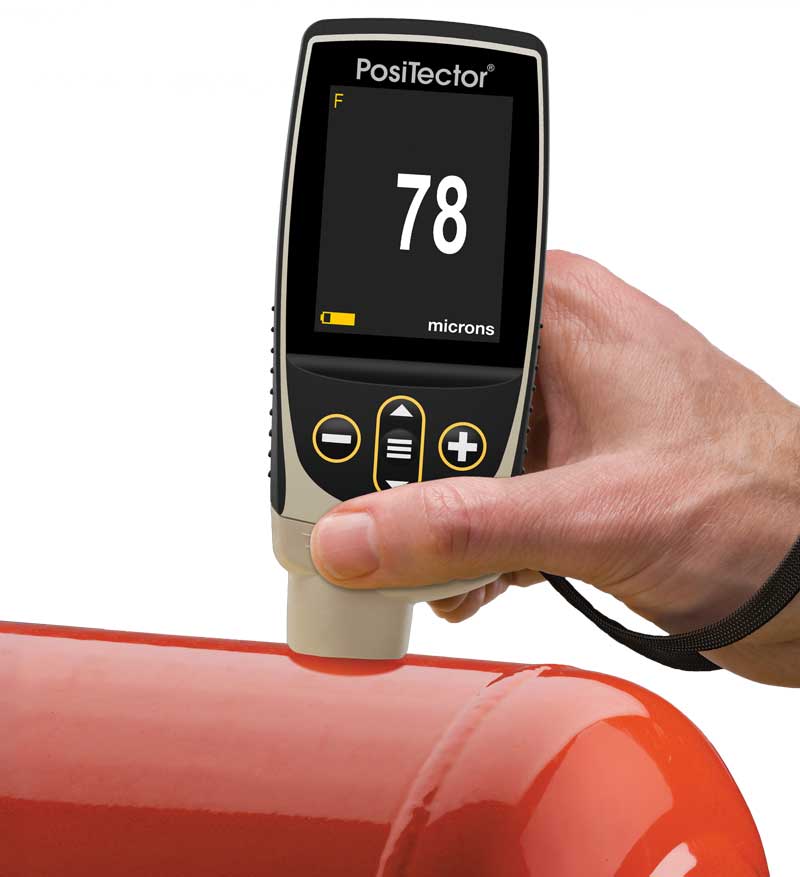

تقيس أدوات التيار المغناطيسي والدامي المسحوق على المعادن. تتطلب التطبيقات غير المعدنية مثل البلاستيك المطلي والخشب تقنية صدى النبض بالموجات فوق الصوتية.
يعمل الاختبار بالموجات فوق الصوتية عن طريق إرسال نبضة بالموجات فوق الصوتية إلى طلاء باستخدام مسبار (محول طاقة) بمساعدة هلام (أو قطرة ماء) يتم تطبيقه مؤقتا على السطح.
يسمح هذا التقدم الجديد نسبيًا للصناعات بإجراء مراقبة الجودة غير المدمرة بسعر معقول at ومن فوائد تقنية القياس هذه إمكانية قياس الطبقات الفردية في نظام طلاء متعدد الطبقات.
يُعد PosiTector 200 B بالموجات فوق الصوتية مثاليًا لقياس سُمك طلاء المسحوق المطبق على ركائز غير معدنية. يتراوح نطاقه من 13 إلى 1000 ميكرومتر (0.5 إلى 40 مل). يصف ASTM D6132 هذا الاختبار.
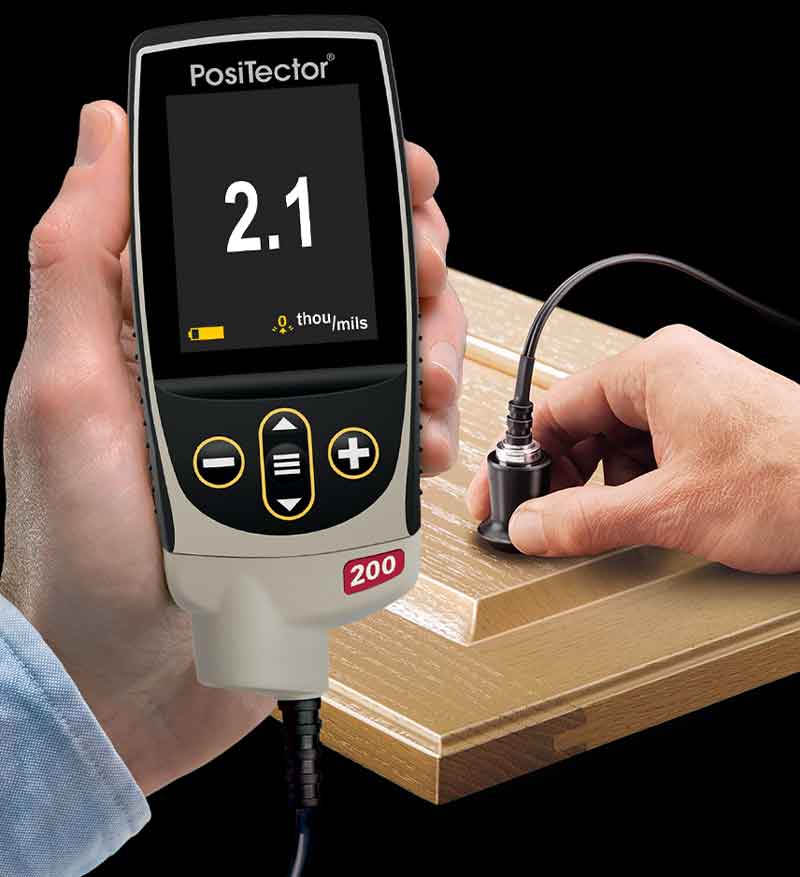
تستخدم الميكرومتر أحيانا للتحقق من سمك الطلاء. لديهم ميزة قياس أي مجموعة طلاء / ركيزة ولكن عيب طلب الوصول إلى الركيزة العارية. يجب أخذ قياسين: أحدهما مع الطلاء في مكانه والآخر بدونه. الفرق بين القراءتين ، اختلاف الارتفاع ، يؤخذ على أنه سمك الطلاء.
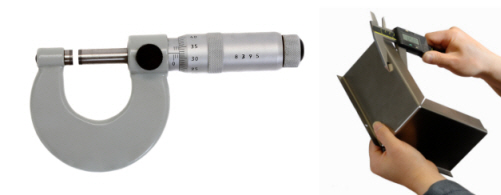
تتوفر تقنيتان مدمرتان. الأول هو قطع الجزء المطلي في مقطع عرضي وقياس سمك الفيلم من خلال عرض القطع مجهريا. تستخدم التقنية الأخرى مجهرا مصغرا لعرض شق هندسي من خلال الطلاء المعالج. تستخدم هذه الطريقة عندما تكون الطرق غير المدمرة غير ممكنة أو كوسيلة لتأكيد النتائج غير المدمرة. تصف طريقة اختبار ASTM D4138 القياسات المدمرة على ركائز صلبة مصنوعة من أدوات المقطع العرضي.
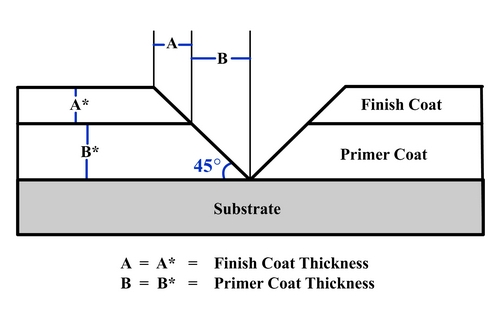

تتم طرق القياس الموصوفة حتى الآن بعد معالجة مسحوق الطلاء. ولكن إذا تم تطبيق الطلاء بشكل غير صحيح ، فإن التصحيح بعد العلاج يتطلب وقت عمل إضافي مكلف ، وقد يؤدي إلى تلوث الفيلم ، وقد يؤدي إلى مشاكل الالتصاق وسلامة نظام الطلاء. يمكن أن يحدد قياس سمك الفيلم قبل المعالجة الحاجة إلى التصحيح والتعديل الفوري بواسطة القضيب.
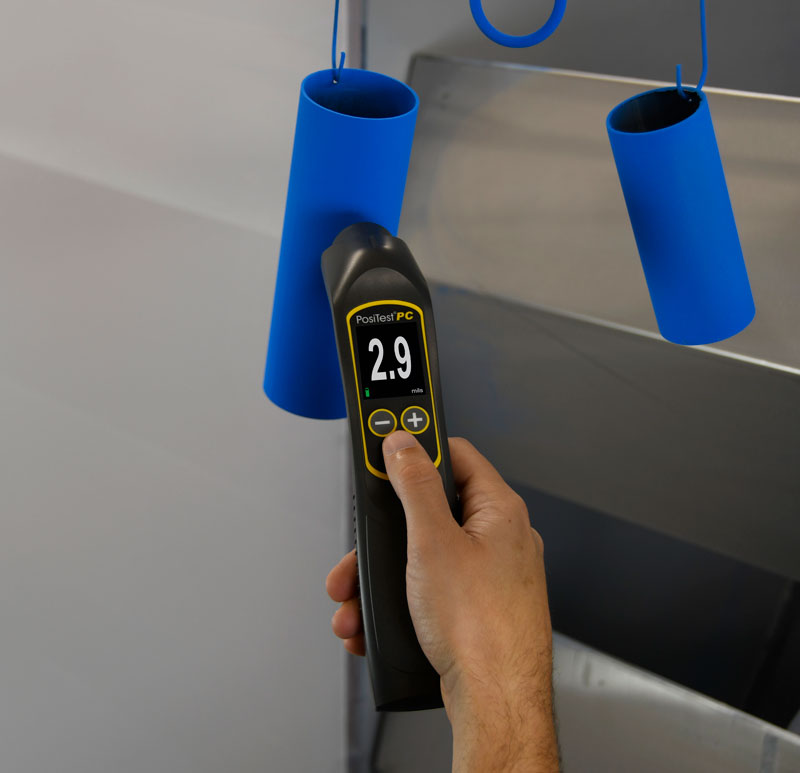
في حين أن معظم مواصفات طلاء المسحوق تعطي أهدافا للسمك المعالج ، فمن الممكن تحديد ما إذا كان المسحوق المطبق ضمن مواصفات السماكة قبل الانتهاء من المعالجة والربط المتشابك.
هناك أسباب وجيهة للرغبة في التنبؤ الدقيق بسمك المعالجة ، خاصة على الخطوط المتحركة. اعتمادا على طول الفرن ، أي عدد الأجزاء التي يتم معالجتها ، بالإضافة إلى الوقت اللازم لعملية المعالجة والقياس اليدوي لسمك الفيلم بعد المعالجة ، هناك تأخير كبير قبل أن يتمكن المشغل من التدخل في عملية التطبيق لإجراء أي تغييرات ضرورية.
إذا تم اكتشاف عيوب الطلاء ، فيجب إعادة صياغة عدد كبير من الأجزاء المطلية في حلقة إصلاح ، أو إذا ثبت أن إعادة العمل مكلفة للغاية ، فقد يتعين التخلص منها. بالنسبة لبعض العمليات ، لم تعد هذه العيوب مقبولة لتلبية متطلبات عمليات التشطيب الحديثة.
يساعد قياس المسحوق في الحالة المعالجة مسبقا والمعالجة مسبقا على ضمان سمك الفيلم المعالج الصحيح. إنه يتيح إعداد نظام التطبيق وضبطه قبل المعالجة. وهذا بدوره سوف يقلل من كمية الخردة والإفراط في الرش. تساعد التنبؤات الدقيقة على تجنب التجريد وإعادة الطلاء الذي يمكن أن يسبب مشاكل في الالتصاق وسلامة الطلاء.
يصف ASTM D7378 ثلاث طرق قياس لسمك مساحيق الطلاء المطبقة والمعالجة مسبقا للتنبؤ بسمك معالج.
أ. معدن صلب محزز (مشط) العدادات.
ب. عدادات الطلاء الإلكترونية مع مسبار مسحوق خاص.
ج. عدم الاتصال بأدوات الموجات فوق الصوتية.
يستخدم الإجراء A مقاييس مثل مشط مسحوق DeFelsko غير المكلف الذي يعمل بنفس الطريقة التي يعمل بها مقياس سمك الفيلم الرطب. يتم سحب المشط من خلال المسحوق غير المعالج ويعتبر ارتفاع المسحوق قيمة نطاق بين أعلى سن مرقمة صنعت علامة ولها مسحوق يتشبث بها ، والسن الأعلى التالي الذي لم يترك أي علامة وليس له مسحوق يتشبث به.
هذه العدادات غير مكلفة نسبيا. تتوفر نماذج مختلفة من مشط المسحوق تسمح بإجراء قياسات من 75 إلى 1250 ميكرون (3 إلى 50 مل) على أي ركيزة. إنها مناسبة فقط كدليل لأن الفيلم المعالج قد يكون مختلفا بعد التدفق. قد تؤثر العلامات التي خلفها المقياس على خصائص الفيلم المعالج.

يستخدم الإجراء B مقياس سمك طلاء التيار المغناطيسي أو الدوامي التقليدي ولكن مع مسبار مسحوق مصمم خصيصا لقياس سمك مسحوق الطلاء. ثلاثة دبابيس صغيرة ، مدمجة في المسبار ، تخترق مسحوق الطلاء وصولا إلى الركيزة. يتم ضغط المسبار يدويا على سطح المسحوق لإجراء قياس الارتفاع. ينطبق هذا الإجراء على الركائز المعدنية فقط. يمكن عمل علامات في المسحوق قد لا يتم تغطيتها عندما يتدفق المسحوق في عملية المعالجة.
ينتج عن الإجراء A والإجراء B قياس ارتفاع مسحوق الطلاء غير المعالج فقط. ولكن غالبا ما يتم ذكر مواصفات السماكة في سمك المسحوق المعالج. نظرا لأن مساحيق الطلاء تتناقص بشكل عام في السماكة أثناء عملية المعالجة ، فإن هذين الإجراءين يتطلبان إنشاء عامل اختزال للتنبؤ بسمك الفيلم المعالج لكل مسحوق طلاء معين.
يتم الحصول على عامل التخفيض هذا عن طريق قياس سُمك المسحوق المعالج at نفس الموقع الذي تم فيه قياس سُمك المسحوق غير المعالج. للحصول على أفضل دقة، يجب أخذ القياسات قبل المعالجة وبعدها لسماكات مختلفة.
يظهر هنا نموذج لنتائج القياس. من هذه المؤامرة ، يمكن تحديد عامل الاختزال وتطبيقه على جميع قياسات سمك مسحوق الطلاء الجاف المستقبلية للتنبؤ بسمك معالج.
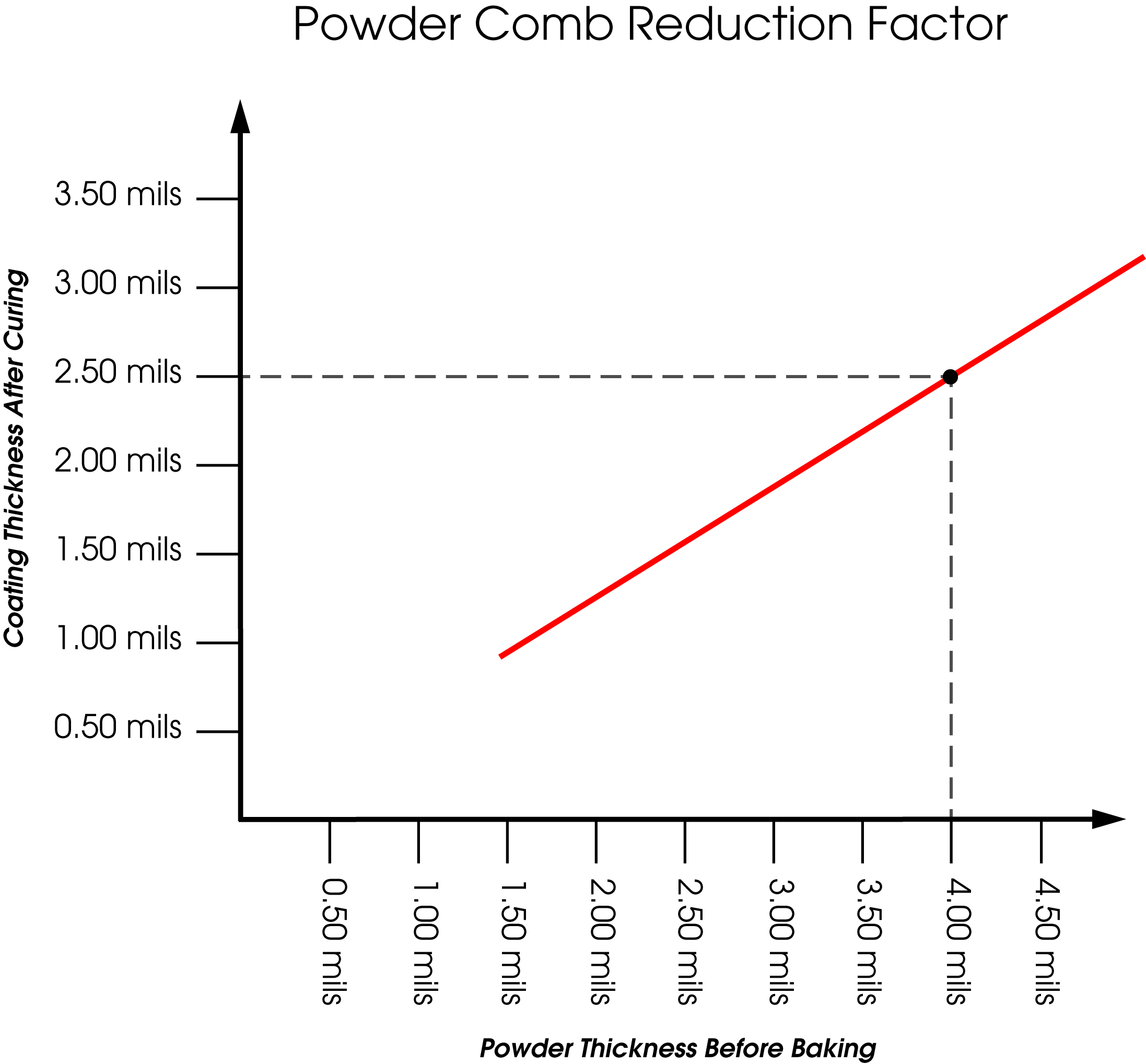
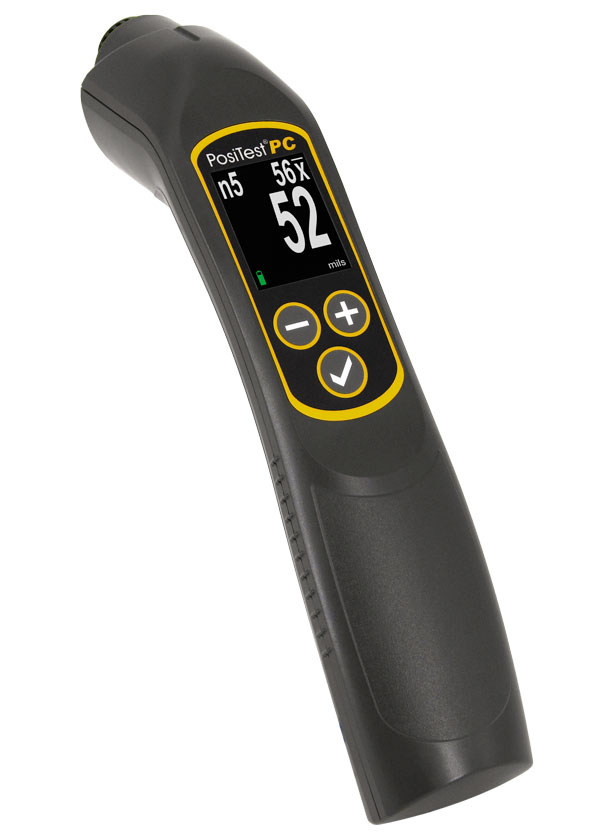
يصف الإجراء C من ASTM D7378 من ASTM D7378 نوعًا جديدًا نسبيًا من الأدوات، مثل جهاز فحص المسحوقPC PosiTest . وهو جهاز بالموجات فوق الصوتية يمكن استخدامه بشكل غير تدميري على المسحوق غير المعالج للتنبؤ بسُمك الطبقة المعالجة.
جهاز فحص المسحوقPosiTest PC محمول باليد ويعمل بالبطارية ويعمل مباشرةً خارج الصندوق لمعظم المساحيق. يتيح تشغيله البسيط وتصميمه المتين استخدامه بسرعة وكفاءة من قبل مشغلي الخطوط.
تتميز أدوات سمك الطلاء غير الملامسة بكونها غير مدمرة. هذا يعني أنه بعد القياس يمكن إعادة إدخال المكونات المقاسة في العملية دون أن تتلف.
للتشغيل ، اضغط على "علامة الاختيار" واحتفظ بها حوالي 19 مم (0.75 بوصة) من الجزء لمدة 1 إلى 3 ثوان. تظهر نتيجة السماكة المعالجة المتوقعة على الفور على الشاشة.
العادي standard يستخدم في قياس سمك المسحوق هو مل ، حيث 1 مل يساوي جزء من الألف من البوصة (1/1000 "). لذلك إذا كان السمك المحدد للشركة المصنعة هو 2 إلى 5 مل ، فيجب أن يكون سمك المسحوق النهائي المعالج بين 0.002 و 0.005 من البوصة.
تسمى وحدة القياس المترية بالميكرون حيث 25.4 ميكرون يساوي 1 مل. يجب على أدوات التطبيق تطبيق المسحوق بالتساوي ووفقا لورقة مواصفات المنتج.
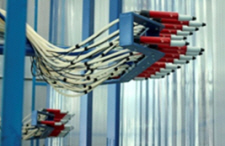
لا يزال طلاء المسحوق هو الأسرع نموا بين جميع تقنيات التشطيب. إنه طلاء جذاب مثل النهاية الواقية التي تدوم طويلا ، ومقاومة عالية للرقائق والخدوش والبهتان. يوفر طلاءا سلسا من مجموعة غير محدودة تقريبا من الألوان والقوام والتشطيبات.
طلاء المسحوق هو عملية فعالة من حيث التكلفة من خطوة واحدة لا تتطلب طبقات متتالية وأوقات معالجة طويلة. جزيئات المسحوق المستخدمة هي مزيج من الصباغ المطحون ناعما وجزيئات الراتنج. يتم نقل جزيئات المسحوق المشحونة إلى سطح مؤرض كهربائيا. توجد مجموعة متنوعة من العمليات لتطبيق المسحوق. تتراوح هذه التطبيقات من الرش الكهروستاتيكي للطلاءات الرقيقة (0.001 "-0.010") إلى الغمس في طبقة مميعة للطلاءات السميكة (0.007 "-0.040").
أثناء عملية المعالجة ، يتم دمج المسحوق في طبقة ناعمة. اعتمادا على العملية ، يتم معالجة المساحيق إما بالحرارة (الحمل الحراري أو الأشعة تحت الحمراء) أو المعالجة بالأشعة فوق البنفسجية. قد تكون المساحيق المستخدمة إما لدن بالحرارة (نفس التركيب الكيميائي بعد إعادة التدفق) أو بالحرارة (مرتبطة كيميائيا مع نفسها أو غيرها من المكونات التفاعلية).
تم استخدام مسحوق الطلاء على الأسطح المعدنية لأكثر من 50 عاما. وقد وسعت التطورات الحديثة استخدامه في تطبيقات السيراميك والبلاستيك (النايلون والبولي كربونات) و MDF (الألواح الليفية متوسطة الكثافة). الدراسات جارية لتوسيع استخدام مسحوق الطلاء لتشمل ركائز مثل الأخشاب الصلبة والأرضيات الخشبية وألواح الخشب المضغوط.
على عكس المساحيق المعالجة حراريا ، تفصل مساحيق UV Curable مراحل الذوبان وتكوين الفيلم عن مرحلة المعالجة النهائية. تسمح الأشعة تحت الحمراء قصيرة الموجة وحرارة الحمل الحراري باستخدام درجات حرارة منخفضة نسبيا لعملية الذوبان. والنتيجة هي معالجة درجة حرارة منخفضة مع تدفق محسن. يعتمد الطول الموجي للأشعة فوق البنفسجية والوقت اللازم للمعالجة على اللون وسمك الفيلم المتوقع. يمكن أن يتراوح سمك الطلاء من 20 إلى 100 ميكرون (1 إلى 4 مل). تتمثل أهم تحديات المعالجة بالأشعة فوق البنفسجية في التكلفة الحالية للمساحيق المطلوبة ، فضلا عن الحاجة إلى وضع ضوء الأشعة فوق البنفسجية لضمان تغطية بنسبة 100٪.
نظرا لأن المعالجة بالأشعة فوق البنفسجية لا تتطلب درجات حرارة عالية للمعالجة ، يمكن تحقيق انخفاض كبير في المساحة المطلوبة والناقلات والأرفف لعملية التبريد. على عكس الحرارية ، توفر الأشعة فوق البنفسجية معالجة فورية تزيد بشكل كبير من الإنتاجية. تعتبر وفورات العملية كبيرة بسبب انخفاض الطاقة والمعدات اللازمة للتدفئة. مساحيق الأشعة فوق البنفسجية سهلة التنظيف وإعادة التدوير ، مع توفير عملية خالية من المركبات العضوية المتطايرة.
يتم توسيع الأسواق المتاحة حيث تسمح درجات حرارة المعالجة المنخفضة بطلاء الركائز الحساسة للحرارة (g الألواح الليفية متوسطة الكثافة والبلاستيك) بالمسحوق. كما أن تكلفة طلاء الأجزاء الكبيرة ذات الكتلة الكبيرة (g كتل المحرك) التي تعمل كمشتتات حرارية للمعالجة الحرارية تنخفض أيضًا بشكل كبير باستخدام المعالجة بالأشعة فوق البنفسجية.
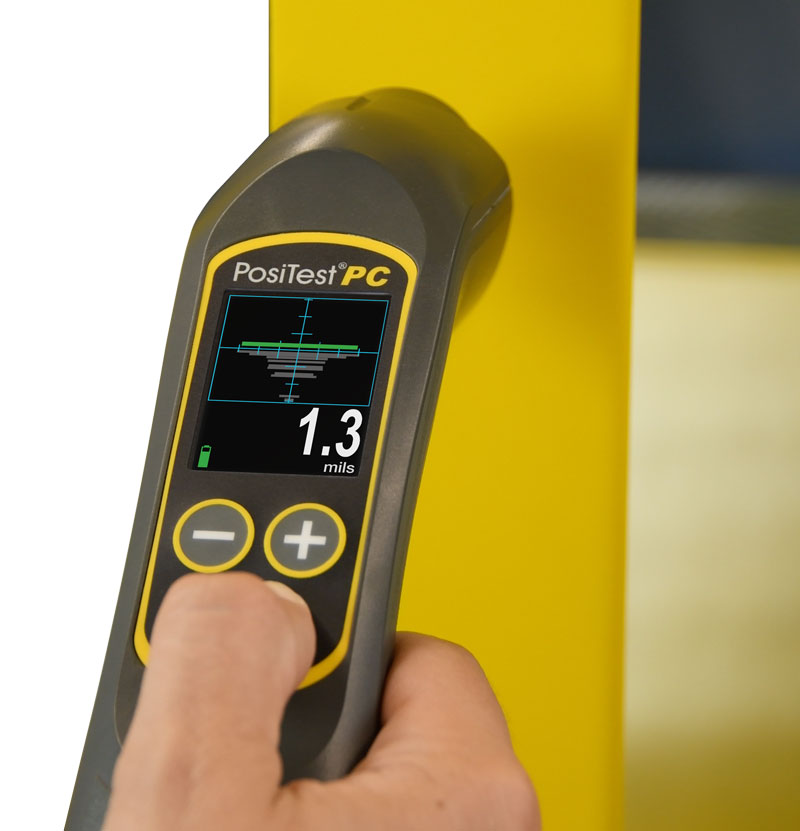
تم تصميم الطلاءات لأداء وظيفتها المقصودة بشكل أفضل عند تطبيقها ضمن نطاق سمك ضيق كما هو محدد من قبل الشركة المصنعة. هذا يضمن الأداء الأمثل للمنتج. تتأثر العديد من الخصائص الفيزيائية والمظهر للطلاء النهائي بسمك الفيلم. يمكن أن يؤثر سمك الفيلم على اللون واللمعان والالتصاق والمرونة ومقاومة الصدمات وصلابة الطلاء. يمكن أن يتأثر ملاءمة القطع المجمعة بعد الطلاء عندما لا يكون سمك الفيلم ضمن التسامح. لذلك ، يجب تطبيق الطلاء ضمن مواصفات معينة لسمك الفيلم الأدنى والأقصى لتحسين الاستخدام المقصود منها.
عندما يتم تطبيق طلاء مسحوق غير كاف ، فإنه لا يوفر تغطية وحماية كافية. على سبيل المثال ، تتطلب المعادن سماكة طلاء كافية للحماية الكافية من الآثار البيئية مثل التآكل (الفولاذ) أو الأكسدة (الألومنيوم). بالإضافة إلى ذلك ، قد يؤدي سمك طلاء المسحوق غير الكافي إلى ضعف تشطيب السطح ومظهر أو لون غير مرغوب فيه.
قد يؤثر سمك مسحوق الطلاء أيضا على مقاومة تأثير التطبيق ، والمرونة ، والصلابة ، وتغطية الحواف ، ومقاومة الرقائق ، والعوامل الجوية ، ومقاومة رش الملح ، والقدرة على الاحتفاظ باللمعان. توفر الشركات المصنعة ورقة مواصفات الإنتاج لمواد طلاء المسحوق. تحاول طبقات البودرة تطبيق طبقة متساوية تلبي هذه المواصفات. تمكن نتائج قياسات مسحوق الطلاء المطلي من ضبط عملية الطلاء وفقا للمواصفات.
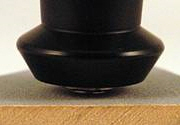
على الألواح الليفية متوسطة الكثافة (MDF)، على سبيل المثال، تتراوح سماكة الطلاء بالمسحوق عادةً بين 1 و8 مل (25 إلى 200 ميكرون) أو حتى أعلى من ذلك بالنسبة للطلاءات البلاستيكية الحرارية. وعادةً ما تكون الطبقة النهائية أكثر متانة مع تغطية أكثر سمكًا. وغالباً ما تستدعي مواصفات المصنع وجود تفاوت ± 1 ميل. لا يمكن تحديد هذا المستوى من الجودة بمجرد النظر at .
هناك فوائد أخرى لقياس سمك التشطيب بدقة سواء لتلبية ISO والجودة ومتطلبات العملاء للتحكم في العملية أو للتحكم في التكاليف. عندما تفشل الشركات في فحص جودة طلاء المواد الواردة والتحقق منها ، فإنها تهدر المال في إعادة صياغة المنتج. من خلال فحص معدات التطبيق الخاصة بهم ، فإنهم يضمنون تطبيق الطلاء وفقا لتوصيات الشركات المصنعة. يؤدي تطبيق سمك الفيلم المفرط إلى المخاطرة بإمكانية العلاج غير الكامل ويمكن أن يقلل بشكل كبير من الكفاءة الكلية. قد يؤدي الكثير من طلاء المسحوق إلى ضعف الالتصاق ويميل إلى التقشير أو التشقق من الركيزة. يمكن أن يقلل الاختبار المنتظم من عدد عمليات إعادة العمل الداخلية وعوائد العملاء بسبب عيوب التشطيب.
يمكن أن تساعد معدات مراقبة الجودة عالية التقنية الشركات على زيادة استخدام الطلاء وتعزيز أرباحها النهائية. في الماضي ، كانت معدات اختبار الألوان والسماكة المكلفة والمعقدة تلبي احتياجات الشركات الكبيرة ذات الميزانيات الأكبر. ومع ذلك ، في السنوات القليلة الماضية ، انخفض سعر معدات اختبار مراقبة الجودة مع التقدم التكنولوجي ، مما يجعل شراء المعدات أكثر عملية وبأسعار معقولة للشركات الصغيرة ذات الميزانيات الضيقة.
كانت التطورات التكنولوجية هي المفتاح لتزايد توافر معدات اختبار السماكة. ساعدت هذه التحسينات الشركات المصنعة على إنتاج أجهزة أصغر حجما وأكثر قابلية للحمل ومتينة وسهلة الاستخدام. كما انخفضت أسعار مقاييس السماكة لأن المواد المستخدمة في إنتاجها أكثر وفرة. يتم إنتاج نفس المواد بكميات كبيرة لاستخدامها في الهواتف المحمولة وأجهزة الكمبيوتر.
يمكن إجراء قياسات سمك مسحوق الطلاء باستخدام طرق مختلفة اعتمادا على الركيزة وما إذا كان يتم إجراء الاختبار قبل أو بعد علاج المسحوق. لدى ASTM سلسلة من الوثائق التي تصف هذه التقنيات.

ديفيد بيميش (1955-2019) ، الرئيس السابق لشركة DeFelsko Corporation ، وهي شركة مقرها نيويورك لتصنيع أدوات اختبار الطلاء المحمولة التي تباع في جميع أنحاء العالم. حصل على شهادة في الهندسة المدنية وأكثر من 25 عاما من الخبرة في تصميم وتصنيع وتسويق أدوات الاختبار هذه في مجموعة متنوعة من الصناعات الدولية بما في ذلك الطلاء الصناعي وفحص الجودة والتصنيع. أجرى ندوات تدريبية وكان عضوا نشطا في العديد من المنظمات بما في ذلك NACE و SSPC و ASTM و ISO.